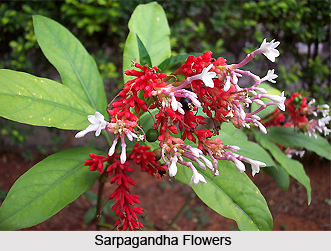 Sarpagandha, Indian medicinal plant is botanically named Rauvolfia Serpentina. This Indian medicinal plant, also known as Snakeroot, is given various names in different states. Sarpagandha is known as Dhanbarua in Orissa, Harki in Maharashtra, Sarpagandhi in Karnataka, Patalagarud in Goa, Tulunni in Kerala, Patala Gandi in Andhra Pradesh and Covannamiloori in Tamil Nadu. This plant is distributed from the east of Punjab to Nepal, Sikkim, Bhutan and Assam, in the lower hills of the Gangetic plains, some parts of central India, Eastern Ghats and Western Ghats and in the Andaman Islands. Sarpagandha is generally known for its medicinal properties to treat and cure many diseases. This plant is basically originated in India, though it is an Indo-Malaysian species. In India, this plant is widely distributed and is rarely common. Sarpagandha grows in secondary scrub and grassy habitats in the sub-Himalayan hills.
Sarpagandha, Indian medicinal plant is botanically named Rauvolfia Serpentina. This Indian medicinal plant, also known as Snakeroot, is given various names in different states. Sarpagandha is known as Dhanbarua in Orissa, Harki in Maharashtra, Sarpagandhi in Karnataka, Patalagarud in Goa, Tulunni in Kerala, Patala Gandi in Andhra Pradesh and Covannamiloori in Tamil Nadu. This plant is distributed from the east of Punjab to Nepal, Sikkim, Bhutan and Assam, in the lower hills of the Gangetic plains, some parts of central India, Eastern Ghats and Western Ghats and in the Andaman Islands. Sarpagandha is generally known for its medicinal properties to treat and cure many diseases. This plant is basically originated in India, though it is an Indo-Malaysian species. In India, this plant is widely distributed and is rarely common. Sarpagandha grows in secondary scrub and grassy habitats in the sub-Himalayan hills.
Sarpagandha is found in abundance in the Western Ghats in the moist forests. Apart from these areas, this Indian medicinal plant is also found widely scattered in the shaded under storey of moist deciduous forests as well as in open, secondary scrub forest and grassy moist habitats. It grows on a variety of soils from sea level up to 1200 metres altitude, generally on sites that were previously inhabited. This plant is admired in household and people grow it for getting benefit from this entire plant. Sarpagandha is widely grown in India as well as all over the world.
Sarpagandha is an erect, evergreen sub-shrub. This plant is 0.2m to 0.6 m tall. The stem has no branch and has irregularly longitudinally fissured, pale brown and corky bark. The taproot of this plant is tuberous, soft, sometimes irregularly nodular and bitter. The leaves are placed in whorls of 3 or 4 and are 5cm to 18 cm long and 1.5 cm to 7 cm wide. They are elliptic-Lanceolate or Obovate, apex acute or acuminate, base tapering, the surface is dark green and the beneath of the leaf is pale green and the petioles are 0.6cm to 1.4 cm long.
The flowers of Sarpagandha are white or violet-tinged. The flowers blossom in abundance at a time and have Corymbose Cymes. The peduncles are 0.5 cm to 12.5 cm long. The pedicels are stout, 0.3cm to 0.6 cm long and bright red in colour. The Calyx is bright red with Lanceolate segments and corolla is 1cm to 1.3 cm long. The tube of the plant is slender and cylindrical in shape. The fruits are obliquely ovoid, 0.6 cm in diameter; they grow purplish-black in colour when they get ripe. The seeds are ovoid and the surface is slightly unsmooth. Sarpagandha flowers generally blossom during April to July and bear fruits from July to September. Sometimes the flowering and fruiting may occur year-round.
Medicinal Uses of Sarpagandha
Sarpagandha is considered as one of the best-known medicinal plants in the world. The roots contain major Alkaloid constituents, notably Reserpine, Rescin-Namine and Deserpidine, which are used for medical purpose in India. The root of Sarpagandha that carries immense medicinal properties is widely used even in foreign countries, in the treatment of high blood pressure and as a sedative and tranquillising agent. For centuries, Ayurveda and Unani practitioners reckon the root of Sarpagandha as a hypnotic and sedative, for reducing high blood pressure, and for treating various central Nervous System disorders, both psychic and motor, including anxiety, psychosis, schizophrenia, epilepsy and insomnia. The tribal inhabitants of southern and eastern Bihar take the powdered roots orally as an antidote to snake venom. Extracts of the roots of Sarpagandha plant are valued for treatment of intestinal disorders, particularly diarrhoea and dysentery, and also as an anthelmintic.
The extract of Sarpagandha blended with other plant extracts are used for treating cholera, colic and fever. A decoction of the root is believed to stimulate uterine contractions and is recommended for use in problematic situations in childbirth. The juice of the leaves of Sarpagandha cures opacity of the cornea. The Kondhs of southwest Orissa prepare a drug from the dried fruit, black pepper and ginger and the mixture is taken as a medicine to regularise menstruation.
The name Sarpagandha has been aptly derived for its special usage. For ages, Sarpagandha has been used in many parts of the world as an antidote against bite of poisonous snakes and reptiles.



















